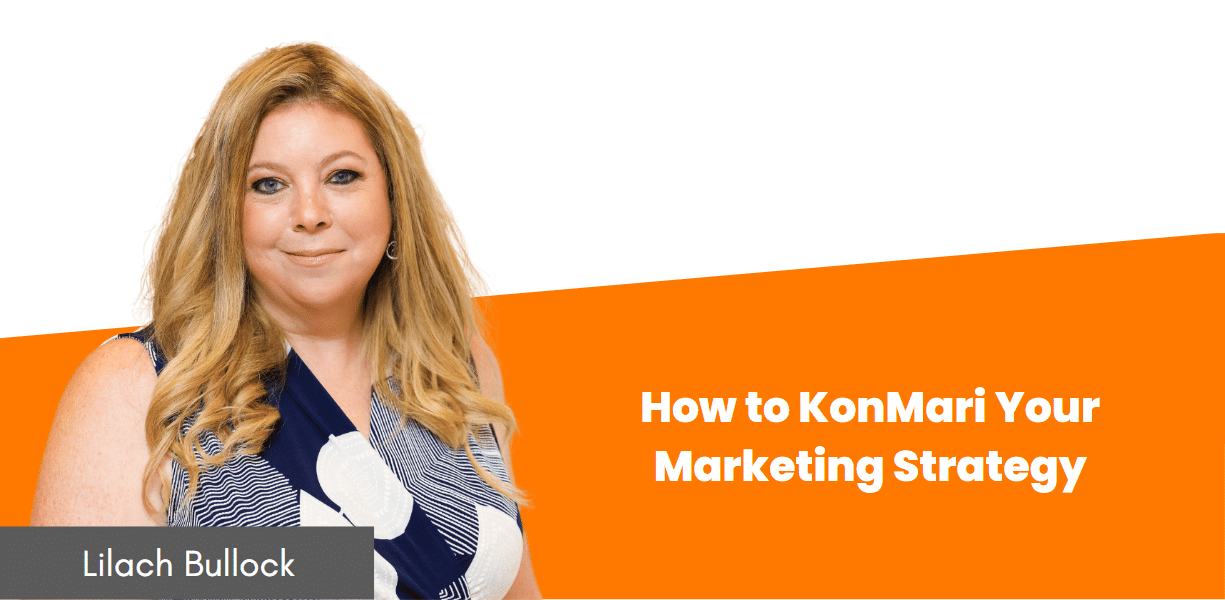Follow Lilach

How to KonMari Your Marketing Strategy
Marie Kondo isn’t just a home organizer; she’s a pioneer. Through her bestselling book, The Life-Changing Magic of Tidying Up, and her subsequent Netflix series, Kondo has singlehandedly revolutionized the way people relate to their belongings (and to a large extent, their decisions). She is famous for asking the question: “Does this spark joy?” The answer is simple – if something brings you joy, keep it around. If not, get rid of it.
Kondo’s decluttering method has been coined the “KonMari method,” and I’d like to suggest that her practices aren’t relevant only to our homes, but to many aspects of both our personal and professional lives. While I could write an entire post about how to KonMari your acquaintances (sad, but true!), this post will focus on how you can use the KonMari method to optimize your marketing strategies in 2020.
It is important to understand that Kondo doesn’t advocate downsizing for the sake of having less. She advocates removing what you don’t love to make more room for the things you do love (AKA things that spark joy). When it comes to marketing, this joy can be understood as ROI. Why spend time, energy and money on marketing campaigns that aren’t bringing you a solid return? Let’s take a look at the steps we can take to KonMari our marketing strategies and optimize them for better returns this year.
Step 1: Get Committed
The first rule of the KonMari method is to truly commit yourself to the cause of getting rid of things. You won’t succeed in scaling back if you make an argument for why you need every single piece of your clothing…or your current marketing strategy. Are you doing things just because your competitors are? Or because you think you need to? Perhaps you’re investing in marketing strategies that aren’t working because you’ve already invested so much time and energy that you aren’t ready to quit now (or ever). If so, you may have fallen victim to the “sunk cost effect.”
According to Christopher Olivola, assistant professor of marketing at Carnegie Mellon’s Tepper School of Business, “the sunk cost effect is the general tendency for people to continue an endeavor, or continue consuming or pursuing an option if they’ve invested time or money or some resource in it. That effect becomes a fallacy if it’s pushing you to do things that are making you unhappy or worse off.” This is, unquestionably, one of the worst reasons to maintain your existing marketing strategy, and one of the most compelling reasons to KonMari your marketing strategy immediately.
When you start the KonMari process, you’ll need to commit to taking a hard, honest look at your marketing roadmap and figuring out what is getting real results, and what parts of your strategy are just wasting your resources. This is hard for a lot of people, so it may be wise to undertake this process with an unbiased consultant who can encourage you to make the necessary hard decisions.
Step 2: Work in a Specific Order
When organizing a home, Kondo believes that you must work in a specific order: start with clothing, then books, papers, miscellaneous items, and mementos. When it comes to applying Kondo’s principles to your marketing strategy, I suggest that a similarly rigid category structure is needed: start with your own website first and then take look at your paid marketing strategies in the following order – PPC, social media, email marketing, and SEO.
Why this order, you may ask? Your website is the most valuable digital space you own. This is where you should be getting most of your leads and conversions. It’s where you’ll have 100% control over your message, and, in an ideal world, the traffic that you are getting. If your website isn’t bringing you ROI, now is the time to fix that. Get rid of the parts that don’t work and see if this improves your performance. If necessary, replace the things you’ve removed with other things (graphics, forms, videos, text) that may work better. But start with getting rid of what’s not working – the things that are not bringing you joy.
An example of a company that made some gut-wrenching cuts is DailyForex, a global financial portal. The company’s website is available in 10 languages, but the team realized over time that several of the languages (including Swedish and Turkish) were very expensive to maintain and had very low ROI. By making the difficult decision to cut back these languages, the DailyForex team was able to focus more resources on the languages that do convert (English and Arabic, for example), and to increase the company’s overall conversion rate by focusing on more relevant traffic.
Once your website is fully optimized, start to look at your external marketing activities. PPC is a natural second step because this is likely where you’re applying most of your marketing budget. Are you running campaigns that aren’t converting? If you’re not getting leads, cut those campaigns. If you’re getting leads but not conversions, ask yourself why. Is it the traffic that’s weak? Is there a problem with the sales funnel? Just as Kondo would tell you that you shouldn’t keep clothing or papers that don’t spark joy or have a specific use, you should not hold onto any marketing strategies that are not sparking ROI in absolute numbers.
When approached by premier web design platform InVision, Aaron Zakowski of Zammo Digital was faced with the challenge of reducing the cost of the company’s PPC signups (specifically on Facebook) and increasing the overall number of leads. Zakowski took a hard look at the campaigns and made some serious cuts. He moved the ad column to the right (less desirable) side of the page to cut costs and axed creatives that weren’t working. The overall result was a 44 percent decrease in Facebook leads cost and an increase in leads by over 1000 percent. If you KonMari your PPC campaigns, you can do it too.
Thanks to all of the great automation options available, your email campaigns should be neither the most time-consuming part of your marketing agenda nor the most expensive. When trying to KonMari your email system, look for the most obvious pain points and see if you can try to eliminate them so that you’ll only be left with the joy. Are you spending too much time on design? Is your open rate repeatedly lower than you’d like? Are you paying too much per send compared to what you’re getting back? Are you getting too many unsubscribes? If you’ve answered yes to any of these questions, it’s time to KonMari your email strategy – stat.
A great case study of optimizing email campaigns is Vivino, a personalized wine company that is heavily internet-based. 80% of Vivino’s revenue comes from email, so optimizing their email mechanism was essential for both maintaining and growing the business. Vivino switched to Twilio’s SendGrid API service to optimize emails and reduce deliverability issues and found a 21 percent increase in their open rate.
Perhaps the biggest challenge when trying to KonMari your marketing efforts is tidying up your SEO strategy. This clean up may come in the form of reducing your site content when it seems most sites are trying to publish more and more. It may be focusing on fewer, higher-quality backlinks, and cleaning out lower quality backlinks that can actually be harming your website. It may be stopping to focus on less important keywords while putting all your efforts into the keywords that bring the most revenue. There are many ways to improve your SEO results by cutting out things that aren’t working, but most marketers are too scared to take this leap, and these decisions should be made with caution, and, if necessary, expert guidance.
Let’s look at a case in which cutting back on the number of pages strengthened SEO efforts. With the help of an outside SEO company, Driving-Tests.org, a website that helps aspiring drivers pass their tests, removed thin and low-performing content and merged important content into longer pages to enhance the user experience and improve the website’s SEO visibility. In addition to technical SEO changes, the tidying up of the site’s content increased organic traffic by 57 percent in 20 months. It would be safe to say that in this case, cutting back certainly increased the joy.
Step 4: Don’t Go Overboard
Anyone familiar with the KonMari method will already know that Ms. Kondo wants her method of “tidying” to be a “special event”, not something that is done regularly. With this in mind, remind yourself that you don’t need to scale back your marketing activities on a regular basis. But you should be doing some serious soul-searching, at the very least, on a semi-annual basis. Think about this as the seasons change, just when you’re going through your closet and removing things you didn’t wear last season.
Step 5: Embrace Your Decisions
Sometimes it’s hard to let things go, even when you know they’re not what you need. Just ask anyone who has been through a painful breakup. But once you’ve decided to let things go, be at peace with your decision. Remind yourself that you’ve made this choice for a reason, and hopefully you’ll find not that the decision is justified, but that your company is experiencing new forms of growth.
 About the author
About the author
Sari Holtz began her career doing online marketing and SEO in the e-commerce sector. For the past nine years, she has been working in the financial sector, building campaigns for brokers with measurable results.

Follow Lilach















